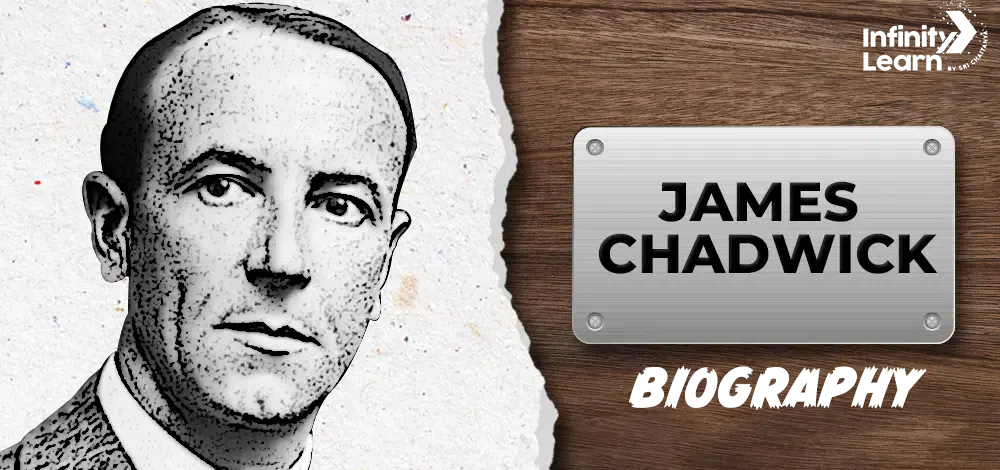Table of Contents
In 1932 James Chadwick found the neutron by experiments, this discovery was recognized and he got Nobel Prize in physics in 1935. Some of his prolific works were actually done while he was in a German prison camp during World War I. During the Second World War, he served a vital part as the head of the British delegation to the Manhattan project which is a team of scientists from United Kingdom, Canada, and USA in the development of the world’s first ever nuclear weapons.
About James Chadwick

James Chadwick was a British physicist in the twentieth century born on October 20, 1891, in Bollington – Cheshire – England. He is famously known for his discovery of an atomic particle called neutron that won him the Nobel prize in physics in 1935. Chadwick remains one of the most important people in the field of nuclear physics due to his work’s influence on science and technology.
James Chadwick Biography in English
James Chadwick received his first formal education in the city of Manchester where he attended Manchester High School and later the University of Manchester among others. There he received bachelor’s and master’s degrees under the supervision of Ernest Rutherford, one of the most prominent physicists of the period. Chadwick completed his B. S degree in 1911 and his M. S in 1913.
During World War I James Chadwick was confined in a civilian prison camp in Germany and it was here that he carried his studies under difficult circumstances. Following the war, he went back to England and continued at the Cavendish Laboratory at the University of Cambridge as a scientific assistant to Rutherford; he completed his Ph. D. in 1921.
Also Check: List of all Biographies
James Chadwick Discovery
In 1932, James Chadwick made his most significant discovery: The neutron is identified as the third kind of natural radioactive particles. He did experiments that established the proof of the existence of this neutral particle in the nucleus of the atom. This was important since it answered why atomic nuclei were having more mass than the protons that were present alone. The discovery of neutron substantially contributed to the knowledge on the structure of atom By developing nuclear fission which is widely applied from production of nuclear power to Atomic weapons.
James Chadwick Experiment
James Chadwick most important experiment included the shooting of alpha particles onto beryllium, which emitted another kind of radiation. After observing the property and interaction of this radiation and its capability of knocking off proton from other materials James Chadwick said that it was made up of neutral particles—neutrons. This experiment not only proved production and existence of the neutron but also led to a numerous development in nuclear physics.
James Chadwick Invention
While James Chadwick is best known for the discovery of the neutron, it should be noted that he did not actually invent any particular device but rather identified a new phenomenon which paved the way for effective development of nuclear science. His work made a way to the device for producing nuclear reactions and the subsequent creation of nuclear reactors and nuclear weapons.
James Chadwick – Career and Earlier Life
Nevertheless, in 1935, Chadwick took up a professorial position in the Department of Physics at the University of Liverpool. He has been involved in World War II whereby he was part of the Allied forces known as the Manhattan Project which aimed at developing the atomic bomb. James Chadwicks being the head of the British Mission to the project was responsible for the knowledge used to produce the first nuclear weapons.
During the post-war period, James Chadwick was knighted in 1945 for services to science. He later became the Master of Gonville & Caius College at the University of Cambridge from 1948 until 1959. Through his teaching and research he continued to have impact in the field of physics until his death on July 24, 1974 in Cambridge, Cambridgeshire, England.
FAQs on James Chadwick Biography
How did James Chadwick discover the neutron?
James Chadwick discovered the neutron in 1932 by bombarding beryllium with alpha particles, producing an unknown radiation that he identified as neutral particles—neutrons.
What did James Chadwick discover?
James Chadwick discovered the neutron, a neutral particle in the atomic nucleus, which was a significant advancement in nuclear physics.
What did James Chadwick study in college?
James Chadwick studied physics at the University of Manchester, under the guidance of Ernest Rutherford, and later at the University of Cambridge.
What were James Chadwick's quotes?
One of James Chadwick's notable quotes is: The world probably being destroyed by the atomic bomb, I want to see what is left and how it looks after the explosion.
Why is James Chadwick famous?
James Chadwick is famous for his discovery of the neutron, which significantly advanced the understanding of atomic structure and nuclear reactions.
Did James Chadwick get a Nobel Prize?
Yes, James Chadwick received the Nobel Prize in Physics in 1935 for his discovery of the neutron.
What was James Chadwick's model called?
James Chadwick did not propose a specific model named after him, but his discovery of the neutron contributed significantly to the development of the nuclear model of the atom.









